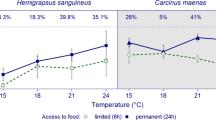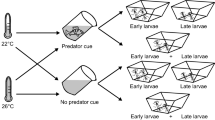Abstract
Pomacea canaliculata is a South American freshwater snail considered as one of the world’s worst invasive alien species. A temperature of around 25 °C has usually been considered to be optimal for rearing P. canaliculata. Nevertheless, snails have not been reared under a wide range of temperatures to reveal the optimum for performance in terms of population increase. We investigated the effect of temperature on growth, survival and reproduction, estimating demographic parameters for P. canaliculata in the wide range of temperatures at which these snails are active (15–35 °C). No reproductive activity was evidenced for the snails reared at 15 °C, probably explained by the small sizes attained at this temperature. Temperatures above 25 °C did not promote a significant acceleration in growth so higher temperatures will not result in a reduction in time to reach maturity. In fact, snails from 25 and 30 °C began reproduction at the same age. We report here for the first time a detrimental effect of high temperatures that provoked a significant decrease in the contribution of snails to the next generation: the viability of eggs from the snails reared at 30 °C was very low and the snails exposed to a constant water temperature of 35 °C were unable to produce eggs. Our findings reveal a new environmental constraint that could be a determinant of the range limits of this species in invaded regions, especially during the coming decades, anticipating the scenario predicted from global warming.



Similar content being viewed by others
References
Albrecht EA, Koch E, Carreño NB, Castro-Vazquez A (2005) Control of seasonal arrest of copulation and spawning in the apple snail Pomacea canaliculata (Prosobranchia: ampullariidae): differential effects of food availability, water temperature and day length. Veliger 47:147–152
Burlakova LE, Padilla DK, Karatayev AY, Hollas DN, Cartwright LD, Nichol KD (2010) Differences in population dynamics and potential impacts of a freshwater invader driven by temporal habitat stability. Biol Invasions 12:927–941
Cazzaniga NJ, Estebenet AL (1988) The effect of crowding on breeding Pomacea canaliculata (Gastropoda, Ampullariidae). Comp Physiol Ecol 13:89–96
Cowie RH (2002) Apple snails (Ampullariidae) as agricultural pests: their biology, impacts and management. In: Barker GM (ed) Molluscs as Crop Pests. CABI Publishing, Wallingford, pp 145–192
Deaton LE, Schmidt W, Leblanc B, Carter J, Mueck K, Merino S (2016) Physiology of the invasive apple snail Pomacea maculata: tolerance to low temperatures. J Shellfish Res 35:207–210
Diamond SE, Nichols LM, McCoy N, Hirsch C, Pelini SL, Sanders NJ, Ellison AM, Gotelli NJ, Dunn RR (2012) A physiological trait-based approach to predicting the responses of species to experimental climate warming. Ecology 93:2305–2312
EFSA (2013) Scientific opinion on the assessment of the potential establishment of the apple snail in the EU. EFSA J 11:3487. doi:10.2903/j.efsa.2013.3487
EFSA (2014) Scientific opinion on the environmental risk assessment of the apple snail for the EU. EFSA J 12:3641. doi:10.2903/j.efsa.2014.3641
Estebenet AL, Cazzaniga NJ (1992) Growth and demography of Pomacea canaliculata (Gastropoda: Ampullariidae) under laboratory conditions. Malacol Rev 25:1–12
Estebenet AL, Cazzaniga NJ (1998) Sex related differential growth in Pomacea canaliculata (Gastropoda: Ampullariidae). J Mollus Stud 64:119–123
Estebenet AL, Martín PR (2002) Pomacea canaliculata (Gastropoda: Ampullariidae): life-history traits and their plasticity. Biocell 26:83–89
Estebenet AL, Martín PR, Burela S (2006) Conchological variation in Pomacea canaliculata and other South American Ampullariidae (Caenogastropoda, Architaenioglossa). Biocell 30:329–335
Gettys LA, Haller WT, Mudge CR, Koschnick TJ (2008) Effect of temperature and feeding preference on submerged plants by the island apple snail, Pomacea insularum (d’Orbigny, 1839) (Ampullariidae). Veliger 50:248–254
Hayes KA, Cowie RH, Thiengo SC, Strong EE (2012) Comparing apples with apples: clarifying the identities of two highly invasive Neotropical Ampullariidae (Caenogastropoda). Zool J Linn Soc 166:723–753
Horgan FG, Stuart AM, Kudavidanage EP (2014a) Impact of invasive apple snails on the functioning and services of natural and managed wetlands. Acta Oecol 54:90–100
Horgan FG, Felix MI, Portalanza DE, Sánchez L, Moya Rios WM, Farah SE, Wither JA, Andrade CI, Espin EB (2014b) Responses by farmers to the apple snail invasion of Ecuador’s rice fields and attitudes toward predatory snail kites. Crop Prot 62:135–143
Iacarella JC, Dick JTA, Alexander ME, Ricciardi A (2015) Ecological impacts of invasive alien species along temperature gradients: testing the role of environmental matching. Ecol Appl 25:706–716
Ito K (2003) Expansion of the golden apple snail, Pomacea canaliculata, and features of its habitat. Food and Fertilizer Technology Center, Extension Bulletin, pp 1–10
Jackson D, Jackson D (2009) Record of Pomacea canaliculata (Lamarck, 1822) (Ampullariidae), exotic mollusk for to North Chile. Gayana 73:40–44
Karatayev AY, Burlakova LE, Karatayev VA, Padilla DK (2009) Introduction, distribution, spread, and impacts of exotic freshwater gastropods in Texas. Hydrobiologia 619:181–194
Kwong KL, Wong PK, Lau SSS, Qiu JW (2008) Determinants of the distribution of apple snails in Hong Kong two decades after their initial invasion. Malacologia 50:293–302
Liu YB, Han W, Xian ZH (2011) Effect of different temperatures on growth, development and feeding of Pomacea canaliculata. J Southern Agric 42:901–905 (in Chinese with English summary)
López MA, Altaba CR, Andree KB, López V (2010) First invasive apple snails in Europe. Tentacle 18:26–28
Lowe S, Browne M, Boudjelas S, De Poorter M (2000) 100 of the World’s worst invasive alien species. The Invasive Species Specialist Group, IUCN, Auckland, p 12
Lv S, Zhang Y, Steinmann P, Yang GJ, Yang K, Zhou XN, Utzinger J (2011) The emergence of angiostrongyliasis in the People’s Republic of China: the interplay between invasive snails, climate change and transmission dynamics. Freshwater Biol 56:717–734
Martín SM (1986) Ciclo reproductivo de Ampullaria canaliculata (Gastropoda; Ampullariidae) en el área rioplatense. Neotrópica 32:171–181
Martín PR, Estebenet AL, Cazzaniga NJ (2001) Factors affecting the distribution of Pomacea canaliculata (Gastropoda: Ampullariidae) along its southernmost natural limit. Malacologia 43:13–23
Matsukura K, Wada T (2007) Environmental factors affecting the increase in cold hardiness in the apple snail Pomacea canaliculata (Gastropoda: Ampullariidae). Appl Entomol Zool 42:533–539
Matsukura K, Tsumuki H, Izumi Y, Wada T (2009) Physiological response to low temperature in the freshwater apple snail, Pomacea canaliculata (Gastropoda: Ampullariidae). J Exp Biol 212:2558–2563
McClary A (1964) Surface inspiration and ciliary feeding in Pomacea paludosa (Prosobranchia: Mesogastropoda: Ampullariidae). Malacologia 2:87–104
Mu H, Sun J, Fang L, Luan T, Williams GA, Cheung SG, Wong CKC, Qiu JW (2015) Genetic basis of differential heat resistance between two species of congeneric freshwater snails: insights from quantitative proteomics and base substitution rate analysis. J Proteome Res 14:4296–4308
Pan Y, Dong S, Yu X (2008) Effects of temperature stress on development, feeding and survival of the apple snail Pomacea canaliculata (Lamarck). Acta Phytophylacica Sin 35:239–244 (in Chinese with English summary)
Ramakrishnan V (2007) Salinity, pH, temperature, desiccation and hypoxia tolerance in the invasive freshwater apple snail Pomacea insularum. PhD Dissertation, University of Texas
Rawlings TA, Hayes KA, Cowie RH, Collins TM (2007) The identity, distribution, and impacts of non-native apple snails in the continental United States. BMC Evol Biol 7:97
Servicio Meteorológico Nacional (2016) http://www.smn.gov.ar/. Accessed 29 April 2016
Seuffert ME, Martín PR (2010) Dependence on aerial respiration and its influence on microdistribution in the invasive freshwater snail Pomacea canaliculata (Caenogastropoda, Ampullariidae). Biol Invasions 12:1695–1708
Seuffert ME, Martín PR (2013) Juvenile growth and survival of the apple snail Pomacea canaliculata (Caenogastropoda: Ampullariidae) reared at different constant temperatures. SpringerPlus 2:312
Seuffert ME, Burela S, Martín PR (2010) Influence of water temperature on the activity of the freshwater snail Pomacea canaliculata (Caenogastropoda: Ampullariidae) at its southernmost limit (Southern Pampas, Argentina). J Therm Biol 35:77–84
Stearns SC (1992) The evolution of life histories. Oxford University Press, New York
Strayer DL (2010) Alien species in fresh waters: ecological effects, interactions with other stressors, and prospects for the future. Freshwater Biol 55:152–174
Tamburi NE, Martín PR (2009) Reaction norms of size and age at maturity of Pomacea canaliculata (Gastropoda: Ampullariidae) under a gradient of food deprivation. J Moll Stud 75:19–26
Tamburi NE, Martín PR (2011) Effects of food availability on reproductive output, offspring quality and reproductive efficiency in the apple snail Pomacea canaliculata. Biol Invasions 13:2351–2360
Wada T (2006) Impact and Control of Introduced Apple Snail, Pomacea canaliculata (Lamarck), in Japan. In: Joshi RC, Sebastian LS (eds) Global advances in ecology and management of golden apple snails. Philippine Rice Research Institute, New Ecija, pp 181–197
Wada T, Yoshida K (2000) Burrowing by the apple snail, Pomacea canaliculata (Lamarck); daily periodicity and factors affecting burrowing. Kyushu Plant Prot. Res. 46:88–93 (in Japanese with English summary)
Yoshida K, Hoshikawa K, Wada T, Yusa Y (2009) Life cycle of the apple snail Pomacea canaliculata (Caenogastropoda: Ampullariidae) inhabiting Japanese paddy fields. Appl Entomol Zool 44:465–474
Yoshida K, Matsukura K, Cazzaniga NJ, Wada T (2014) Tolerance to low temperature and desiccation in two invasive apple snails, Pomacea canaliculata and P. maculata (Caenogastropoda: Ampullariidae), collected in their original distribution area (northern and central Argentina). J Mollus Stud 80:62–66
Yoshie H, Yusa Y (2008) Effects of predation on the exotic freshwater snail Pomacea canaliculata (Caenogastropoda: Ampullariidae) by the indigenous turtle Chinemys reevesii (Testudines: Geoemydidae). Appl Entomol Zool 43:475–482
Yusa Y (2004) Brood sex ratio in the apple snail Pomacea canaliculata (Gastropoda: Ampullariidae) is determined genetically and not by environmental factors. J Moll Stud 70:269–275
Yusa Y (2006) Predators of the Introduced Apple Snail, Pomacea canaliculata (Gastropoda: Ampullariidae): Their Effectiveness and Utilization in Biological Control in Japan. In: Joshi RC, Sebastian LS (eds) Global advances in ecology and management of golden apple snails. Philippine Rice Research Institute, New Ecija, pp 345–361
Zhou WC, Wu YF, Yang JQ (2003) Viability of Ampullaria snail in China. Fujian J Agric Sci 18:25–28 (in Chinese with English summary)
Acknowledgements
This work was funded with grants from CONICET (“Consejo Nacional de Investigaciones Científicas y Técnicas”, PIP 112 200901 00473), UNS (“Universidad Nacional del Sur”, PGI 24/B185) and ANPCyT (“Agencia Nacional de Promoción Científica y Tecnológica, PICT 2012-1956). MES and PRM are researchers in CONICET. We wish to thank to two anonymous reviewers for their helpful comments.
Author information
Authors and Affiliations
Corresponding author
Rights and permissions
About this article
Cite this article
Seuffert, M.E., Martín, P.R. Thermal limits for the establishment and growth of populations of the invasive apple snail Pomacea canaliculata. Biol Invasions 19, 1169–1180 (2017). https://doi.org/10.1007/s10530-016-1305-0
Received:
Accepted:
Published:
Issue Date:
DOI: https://doi.org/10.1007/s10530-016-1305-0




